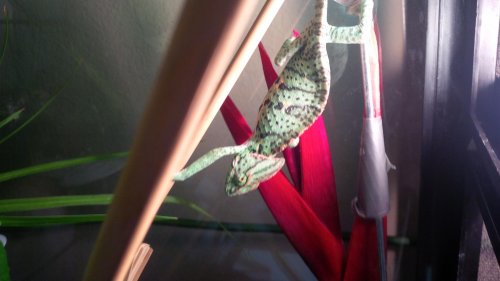My question is actually about colorations and health. I am considering breeding my male ({The Dude}when I get him 100% healthy) with my female (Maud) when she is old enough and ready. I don't know any history or lineage of either animals. The male looks like what I've found being sold online as a "premium" veiled. The female my mother got for me at petsmart. She looks more teal than most other baby female veilds I've seen and when she gets cranky she really turns some darker colors. I attached a couple pictures of her but I cant get the pictures of The Dude to load right now. You can see pictures of him under my thread in the health forum titled "new veiled loaded with issues". His colors have stabled out a lot since I've got him though. Not sure why (assuming it's because he is healthier and happier) but he used to show a lot more yellows and orange spots, now after this shed I am seeing some deep green with bland yellow and light teal. 1)I would like to know what you can predict about the outcome and looks of future babies based on the parents. Would all the babies grow up to look similar or is there a chance for a couple variations? 2) I am assuming my girl is only 6-7 months old so I will wait until she is over a year. I was told he is a little over a year old. Does age difference matter? If hardiness can be passed on then I would say my male has solid genetics, the previous owners didn't take care of him at all and treated him as if he were a leopard gecko or other desert lizard.
I've been wanting to try breeding chameleons to give me something to do and I love them. I think that going through the process and seeing the little hatchlings grow up and taking care of them would be awesome! My idea is that I would build cages for them that are suitable for long term and sell them or give them to people I know would be able to take care of them, keeping at least a few for myself and my daughter. I own a café and have a lot of regular customers that have told me they would love to buy a chameleon from me if I decided to breed them.
I've been wanting to try breeding chameleons to give me something to do and I love them. I think that going through the process and seeing the little hatchlings grow up and taking care of them would be awesome! My idea is that I would build cages for them that are suitable for long term and sell them or give them to people I know would be able to take care of them, keeping at least a few for myself and my daughter. I own a café and have a lot of regular customers that have told me they would love to buy a chameleon from me if I decided to breed them.







